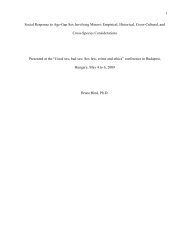Infant and Child Sexuality: A Sociological Perspective - Ipce
Infant and Child Sexuality: A Sociological Perspective - Ipce
Infant and Child Sexuality: A Sociological Perspective - Ipce
Create successful ePaper yourself
Turn your PDF publications into a flip-book with our unique Google optimized e-Paper software.
cause psychoanalytic theory, though gr<strong>and</strong>, mystical, <strong>and</strong> rich in insights,<br />
has not produced many empirically verifiable hypotheses. For<br />
experts in child behavior to use unverified pyschoanalytic insights as<br />
fact is unbecoming <strong>and</strong> potentially dangerous to those who depend on<br />
their counsel. Secondly, psychoanalytic theory has drawn what empirical<br />
support it has largely from observations of small samples of clinical<br />
populations rather than from broad representative samples. In other<br />
words, samples of children <strong>and</strong> adults who are ill, children <strong>and</strong> adults<br />
who have been brought to a therapist or clinic because of some behavior<br />
problem have provided the major source of samples in the past. Psychoanalytic<br />
theory, though inadequately tested, has been utilized as a<br />
source <strong>and</strong> justification for after the fact causal explanations of various<br />
manifestations of sexual behavior.<br />
What we need is not the ab<strong>and</strong>onment of psychoanalytic theory, however.<br />
Psychoanalytic theorists must continue to derive <strong>and</strong> test hypotheses<br />
using psychoanalytic concepts. But what is needed more is that<br />
other behavioral scientists with other theoretical <strong>and</strong> conceptual orientations,<br />
including sociologists, do more to test social theories of<br />
sexual development using large (rather than small), representative<br />
(rather than clinical) populations. It is well known <strong>and</strong> generally accepted<br />
that any aspect of human behavior, including sexual behavior,<br />
benefits from study <strong>and</strong> research using alternative theoretical frameworks.<br />
Sociologists have had much to say about adolescent <strong>and</strong> adult sexuality<br />
in the past, but have given very little attention to infant,<br />
child, <strong>and</strong> preadolescent sexuality. This book brings together what is<br />
known to date in the sociology of the sexuality of the young. We begin<br />
with the sociology of infant sexuality.<br />
The human infant--here defined as being between the ages from birth<br />
up to but not including three years of age--is a creature of potential.<br />
The development of that potential, whether related to mental,<br />
physical, or sexual-erotic aspects of growth, occurs at a very rapid<br />
rate during the first two years of life. Actually the sensing mechanism<br />
is at work much earlier than that--by about the eighth week of<br />
gestation. (Liley, 1972). Until recently the human fetus in situ was<br />
not accessible to study. It was thought that quickening (when the fetus<br />
begins moving limbs <strong>and</strong> trunk) did not take place until the sixteenth<br />
to twentieth week of gestation. Fetal movement is necessary to<br />
the development of bones <strong>and</strong> joints, but the fetus apparently also<br />
moves for the sensual reason of making itself more comfortable in the<br />
uterus. The fetus is responsive to pressure <strong>and</strong> touch--tickling the<br />
scalp <strong>and</strong> stroking the palm, for instance, elicit reactions. In fact,<br />
the areas from which a cutaneous reflex may be obtained are very generalized<br />
in the fetus. (Langworthy, 1933). It is possible that the fetus<br />
is also experienced in sucking before birth. It is not uncommon to detect<br />
the fetus sucking thumbs, fingers, or toes. We can conclude that<br />
at least habituation <strong>and</strong> perhaps even some sensate learning can take<br />
place during the gestation period.<br />
That sensate learning is possible before or outside of the achievement<br />
of self-awareness is at least tangentially supported also in studies<br />
of infant “socialization” among other mammals. Harlow’s report<br />
(Harlow <strong>and</strong> Zimmerman, 1959; Harlow, 1962) on affectional patterns of<br />
rhesus monkeys deprived of interaction with a mother figure is a case<br />
in point. Being deprived of the learning situation provided in normal<br />
4
















